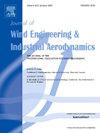混合流入边界条件:解决城市地区不同惯性和粗糙子层流的位移高度
IF 4.9
2区 工程技术
Q1 ENGINEERING, CIVIL
Journal of Wind Engineering and Industrial Aerodynamics
Pub Date : 2025-07-30
DOI:10.1016/j.jweia.2025.106191
引用次数: 0
摘要
准确模拟城市气流和污染物扩散需要反映城市粗糙度复杂性及其对城市边界层(UBL)影响的入口边界条件。本研究评估了四种计算流体动力学(CFD)入流情景,重点改进了使用标准k−ε (SKE)湍流模型在城市环境中速度和湍流动能(TKE)剖面的建模。特别强调的是纳入位移高度和区分粗糙子层(RSL)和惯性子层(ISL)区域。提出了一种新的混合进气道轮廓,以弥补UBL建模中存在的空白。它可以更好地将流动剖面与实验数据结合起来,同时解决RSL和ISL之间的过渡问题。统计评估表明,混合方法在CFD领域提供了更好的性能和一致性。结果强调了准确的入流条件在街道规模分析中的关键作用,其中污染物浓度对流速和TKE剖面高度敏感。研究结果强调了混合配方的潜力,它可以作为一种强大的方法来模拟复杂的城市环境,适应不同的湍流模型和不同的形态特征,如建筑高度可变性和密度。本文章由计算机程序翻译,如有差异,请以英文原文为准。
Blended inflow boundary conditions: Addressing the displacement height in differing inertial and roughness sub-layer flows for urban areas
Accurately modelling urban airflow and pollutant dispersion requires inlet boundary conditions that reflect the complexity of urban roughness and its influence on the urban boundary layer (UBL). This study evaluates four computation fluid dynamics (CFD) inflow scenarios, focusing on improving the modelling of velocity and turbulence kinetic energy (TKE) profiles in urban environments using the Standard (SKE) turbulence model. Particular emphasis is placed on incorporating the displacement height and differentiating between the roughness sub-layer (RSL) and inertial sub-layer (ISL) regions.
A novel blended inlet profile is proposed to bridge existing gaps in UBL modelling. It enables better alignment of flow profiles with experimental data while addressing the transition between the RSL and ISL. Statistical evaluations demonstrate that the blended approach offers improved performance and consistency across the CFD domain.
The results highlight the critical role of accurate inflow conditions in street-scale analyses, where pollutant concentrations are highly sensitive to velocity and TKE profiles. The findings underscore the potential of the blended formulation provides as a robust method for modelling complex urban environments, adaptable to different turbulence models and varying morphometric features such as building height variability and density.
求助全文
通过发布文献求助,成功后即可免费获取论文全文。
去求助
来源期刊
CiteScore
8.90
自引率
22.90%
发文量
306
审稿时长
4.4 months
期刊介绍:
The objective of the journal is to provide a means for the publication and interchange of information, on an international basis, on all those aspects of wind engineering that are included in the activities of the International Association for Wind Engineering http://www.iawe.org/. These are: social and economic impact of wind effects; wind characteristics and structure, local wind environments, wind loads and structural response, diffusion, pollutant dispersion and matter transport, wind effects on building heat loss and ventilation, wind effects on transport systems, aerodynamic aspects of wind energy generation, and codification of wind effects.
Papers on these subjects describing full-scale measurements, wind-tunnel simulation studies, computational or theoretical methods are published, as well as papers dealing with the development of techniques and apparatus for wind engineering experiments.

 求助内容:
求助内容: 应助结果提醒方式:
应助结果提醒方式:


